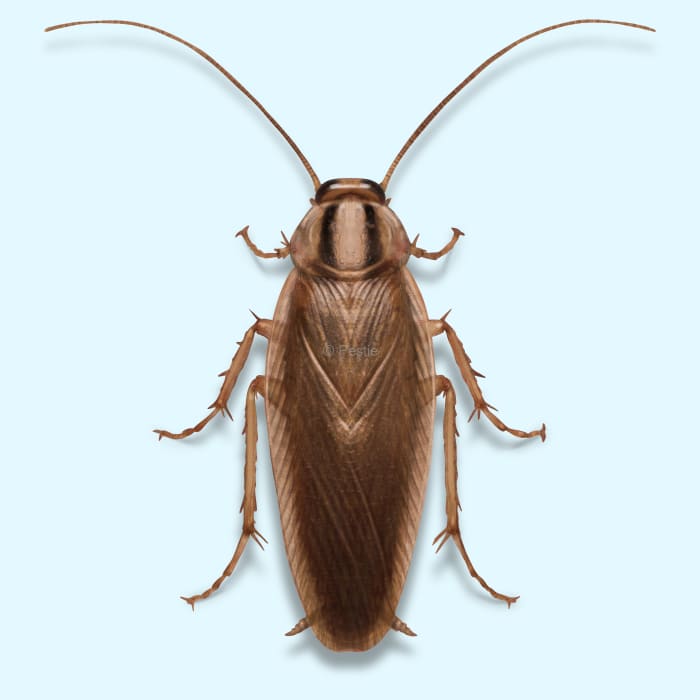How to identify and get rid of German cockroaches

The worldwide conqueror: dealing with German cockroaches
If you’ve ever switched on the bathroom or kitchen light and saw something scurry away, then there’s a good chance you have a German cockroach infestation. That’s because these small cockroaches are some of the most common cockroach pests, found throughout the world.
They are a common problem in apartment buildings, restaurants, hospitals, nursing homes, and even in ships and planes. They are everywhere and can hitchhike in crates, cardboard boxes, and bags.
How to identify German cockroach
German cockroaches are best identified by their long, flat body and two stripes that run behind the head of the cockroach. The nymphs are wingless and have the same two dark brown stripes that extend along the sides of the thorax.
How big are German cockroaches?
German cockroach adults are only ½ to 5/8 inch long, while the nymphs are only 1/8 to 9/16 inch long.
What other pests look like a German cockroach?
Several cockroach species can be found in residential homes, including the American cockroach and Oriental cockroach. Additionally, the Asian cockroach looks very similar to a German cockroach. However, German cockroaches have two stripes on their thorax, don’t fly very well, and will move away from light. Sometimes a wharf borer can also be mistaken for a cockroach.
Where do German cockroaches live?
These well-traveled pests can be found on every continent except Antarctica. They prefer warm and humid environments and can’t survive during extreme cold temperatures.
They have been found in most indoor environments including homes, hotels, warehouses, and public vehicles.
They are light-sensitive and prefer to stay in dark crevices and cracks. They will stay close to sources of food and water, so in homes, you will most likely encounter them in bathrooms and the kitchen.
How to get rid of German cockroaches
One of the best ways to prevent German cockroaches and other cockroach pests from invading and infesting your home is through sanitation.
Keep your home clean of:
- food and drink spills
- water leaks
- trash left inside
- clutter
The first step to controlling this pest is through monitoring susceptible areas. Look under cabinets, inside corners, behind appliances, and in drawers. You can also set out sticky traps beneath sinks, in pantries, or behind a toilet to see if you have any cockroaches in your home.
If you do find cockroaches:
- Vacuuming can remove dead and alive roaches, fecal material, shed skins, or egg casings.
- Gel baits or bait stations can also be helpful to passively reduce numbers.
- Boric acid can also be applied in susceptible areas away from pets and children.
German cockroach pesticide resistance
When it comes to pesticides, German cockroaches have become resistant to many of their effects. This means that even though you spray an off-the-shelf pesticide, it may not be 100% effective at killing all the cockroaches. The ones that are left can then resist the effects of the pesticide, making your spraying wasted. Follow all labels thoroughly before spraying.
Foggers or electronic devices that supposedly repel cockroaches are ineffective at controlling or preventing cockroaches from coming into your home.
A pro-grade pest control spray, however, can be an effective way to deter cockroaches from entering your home in the first place. Pestie offers a pro-grade pest control solution that can be the first line of defense in protecting your home from cockroach invaders.
Treat german cockroaches with Pestie
If you're still having trouble keeping german cockroaches away, the best option is to use a pro-grade, effective pest control solution like Pestie.
Pestie is a do-it-yourself pest control solution that's specially designed to keep german cockroaches and other pests away from your home.
With Pestie, you can rest easy knowing that your living space is protected and free of creepy crawlies. And the best part? It's designed for people, pets, and the planet, so you can say goodbye to harsh chemicals and hello to peace of mind!
- Save hundreds compared to traditional annual pest plans
- People, pet, and planet-friendly
- Pro-grade customized formulas
Quick facts
How dangerous are German Cockroaches?
Medium danger risk
German cockroaches can indirectly harm you and your family. They carry harmful pathogens on their legs, including Salmonella and E. coli, which could lead to food poisoning and dysentery. Additionally, their shed skin and feces can cause allergic reactions for those with asthma or young children.
- Scientific name
Blattella Germanica
- Other common names
Croton Bugs
- Colors
Tan to dark brown, two dark stripes
- Life span
5 to 7 months
- Diet
Meats, starches, sugars, fatty foods, soap, glue, toothpaste
German cockroaches lay their eggs in a leathery pouch called an ootheca. An ootheca can contain anywhere from 35-40 eggs. One female can lay up to 8 oothecas a year!








